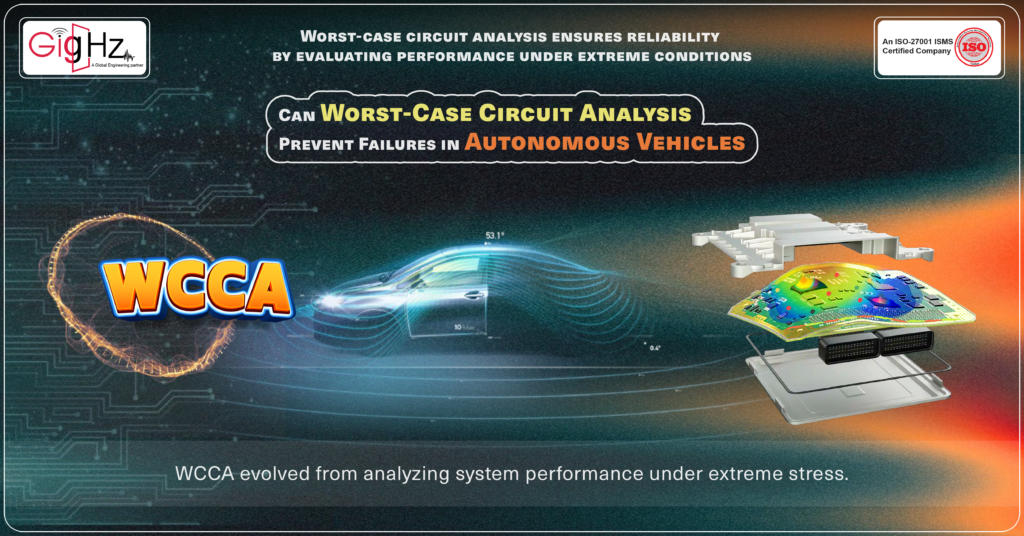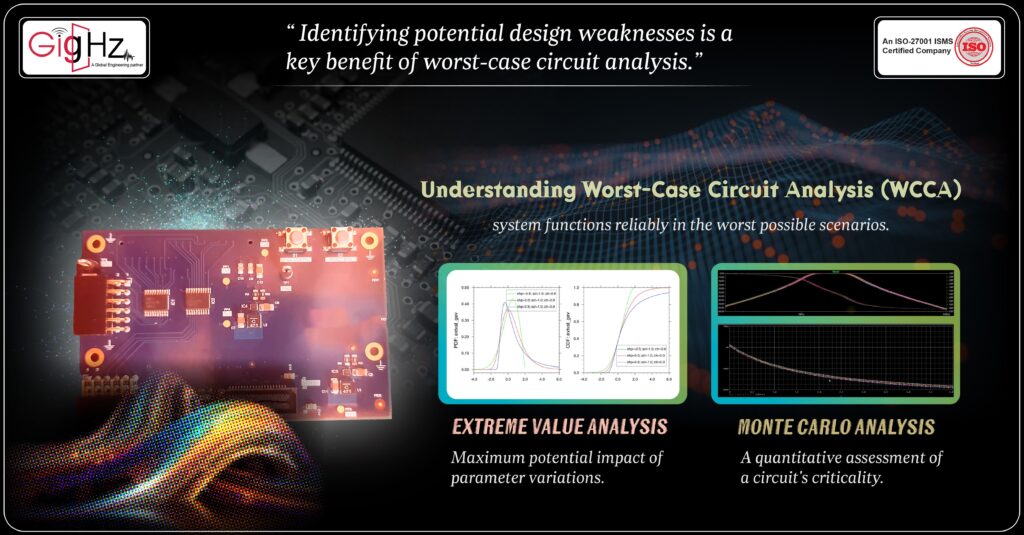Can Worst-Case Circuit Analysis Prevent Failures in Autonomous Vehicles?
- Posted On:
- August 14, 2024
- Category:
- Analysis & Simulation

Worst-case circuit Analysis
Ever wondered how your electronics can handle extreme conditions without breaking a sweat?
It all began with the military and aerospace industries’ need for bulletproof reliability.
Enter worst-case circuit analysis (WCCA): a methodical approach to ensure electronic systems work flawlessly under the toughest scenarios.
Initially developed to meet stringent military standards, WCCA evolved from analyzing component tolerances to predicting system performance under extreme stress.
It’s like stress-testing your gadgets to ensure they won’t fail when it matters most.
From medical devices to spacecraft, WCCA is now a standard practice across industries where reliability is non-negotiable.
It’s not just about meeting regulations—it’s about designing electronics that won’t let you down, no matter the conditions.
With advanced simulations and meticulous testing, WCCA has adapted to today’s high-tech demands.
It’s integrated into the design process to catch potential issues early, saving time and ensuring your devices perform reliably over their lifespan.
As technology evolves, so does WCCA.
Whether it’s your car’s safety system or a vital medical monitor, WCCA ensures your electronics are up to the task.
Ready to dive deeper into how WCCA ensures your gadgets are tough as nails?
Let’s explore the world of worst-case circuit analysis together, that prevent the Autonomous vehicle or not.
Understanding Worst-Case Circuit Analysis (WCCA)

WCCA involves analyzing electronic circuits to determine the worst-case performance under specific operating conditions.
This type of analysis considers the variability in parameters to ensure that the circuit meets its specifications under all circumstances.
Performing worst-case circuit analysis can help identify potential weaknesses in a design and guide decisions on stress and derating analysis.
Techniques such as Monte Carlo analysis can be used to perform a quantitative assessment of a circuit’s criticality.
Extreme Value Analysis helps in understanding the maximum potential impact of parameter variations
By using mathematical tools like Maple or Mathcad, we can conduct sensitivity analysis to understand the impact of parameter variations on circuit performance.
Practicing worst-case circuit analysis is vital in circuit design and analysis to ensure that the circuit or system functions reliably in the worst possible scenarios.
This type of analysis often involves criticality analysis to determine the most important parameters affecting the design.
In addition to Monte Carlo simulations, extreme value analysis, root sum square analysis can also be utilized to evaluate the performance of an electronic circuit.
Tools like OrCAD and MATLAB can facilitate the analysis and aid in predictions for the circuit board or schematic. EVA are other analysis features that can help in the design process by identifying and addressing potential vulnerabilities.
Can Worst-Case Circuit Analysis Prevent Failures in Autonomous Vehicles?

Performing worst-case circuit analysis
Autonomous vehicles promise to revolutionize transportation with their advanced technology, but ensuring their electronic systems work flawlessly is crucial.
That’s where worst-case circuit analysis (WCCA) comes in—it’s like stress-testing to make sure everything works even under tough conditions.
Why It Matters for Autonomous Vehicles?
Keeping You Safe with Reliability
Autonomous vehicles rely entirely on their electronic systems to perceive their surroundings, make split-second decisions, and navigate safely.
These systems include sensors that detect obstacles, processors that interpret data, and actuators that control vehicle movements. Ensuring these components operate flawlessly is paramount for passenger safety.
During worst-case scenario simulations, such as sudden sensor failures or unexpected road conditions, engineers can identify vulnerabilities in the system. This proactive approach allows them to redesign components or implement backup systems to maintain safe operation, minimizing the risk of accidents or malfunctions.
Meeting Standards
Safety standards for autonomous vehicles are stringent and vary by region. Regulatory bodies require manufacturers to demonstrate that their vehicles can handle a wide range of potential hazards without compromising safety. Worst-case circuit analysis (WCCA) plays a critical role in this process by assessing how well the vehicle’s electronics perform under diverse and challenging conditions.
Regulatory tests may simulate scenarios like sudden obstacles appearing in front of the vehicle or sensor malfunctions in crowded urban environments. WCCA ensures that autonomous systems can react appropriately to these situations, meeting or exceeding safety standards set by authorities.
Making Things Run Smoothly
Autonomous vehicles operate in dynamic and unpredictable environments where weather conditions, road surfaces, and other external factors can vary greatly. To ensure consistent performance, engineers use WCCA to simulate these conditions during the design phase.
Extreme temperatures, whether hot or cold, can affect sensor accuracy and processor efficiency. By incorporating WCCA, engineers can anticipate these environmental extremes and optimize the vehicle’s electronic systems to maintain reliable performance in any climate.
By addressing these aspects comprehensively, manufacturers can enhance the safety, reliability, and regulatory compliance of autonomous vehicles through effective application of worst-case circuit analysis.
Challenges in Making It Work
- Complex Systems: Autonomous vehicles use many different parts that all need to work together perfectly. WCCA helps figure out how to make these parts work in the worst situations. Integrating sensors, processors, and actuators from different manufacturers into a cohesive system requires detailed analysis of how each component reacts under various stress conditions.
- Dealing with Changes: Roads can change quickly, and so can the weather. WCCA has to think about all these changes to make sure autonomous vehicles stay safe and reliable. A sudden downpour can affect how sensors detect lane markings or obstacles. WCCA helps engineers test how the vehicle responds to these changing conditions to ensure safety.
Examples from the Real World
- Tesla’s Safety Checks: Tesla uses WCCA to test its self-driving features like Autopilot. They check if sensors and software can handle any unexpected problems on the road. Tesla conducts extensive simulations to ensure that Autopilot remains functional even if a sensor fails or if there are sudden changes in road conditions.
- Waymo’s Smart Cars: Waymo uses WCCA to make sure their autonomous cars can handle anything they might face. This testing helps them keep their cars safe and ready for everyday use. Waymo’s WCCA process includes testing for scenarios such as sensor failures or unexpected road obstacles to ensure their self-driving technology operates reliably and safely.
Looking Ahead
5. Better Testing Tools: As technology gets better, so do the tools for testing. WCCA will keep improving to make sure autonomous vehicles are as safe and reliable as possible.
Advancements in simulation software and hardware-in-the-loop testing allow for more accurate predictions of how autonomous systems will behave in worst-case scenarios.
6. Following the Rules: As more self-driving cars hit the roads, rules about how safe they need to be will get clearer. WCCA will keep helping engineers meet these rules and keep you safe.
Regulatory bodies continuously update safety standards for autonomous vehicles, requiring manufacturers to demonstrate compliance through rigorous WCCA and testing processes.
Final Thoughts
By using Maple and other analysis tools, engineers can account for manufacturing variations, part tolerances, and operating conditions throughout the life cycle of a product.
WCA often includes performing a worst-case circuit analysis (WCCA) to ensure that electrical performance meets specifications with a high degree of confidence.
By incorporating failure mode effects and criticality analysis (FMECA) and mean time between failures (MTBF), designers can identify potential failure modes and mitigate risks early in the design process.
Additionally, utilizing bill of materials (BOM) and statistical analysis allows for a cost-effective means of screening a design to ensure reliability.
Worst-case analysis (WCA) is crucial in electronic design – Incorporating Worst-case circuit analysis (WCCA) ensures electrical performance meets specifications –
Using Maple and analysis tools accounts for manufacturing variations and part tolerances – FMECA and MTBF help identify potential failure modes and mitigate risks early on.
Stay updated on our services—connect with our founder on LinkedIn: https://www.linkedin.com/in/chandra-thimma/recent-activity/all/
Table of Contents
Latest Post
Get Customized Engineering CAD Design Service

Book a Free Consultation Call
Partner with Gighz and bring your most innovative design concepts to life. Our engineering cad services accelerate development so you can focus on your big vision.


